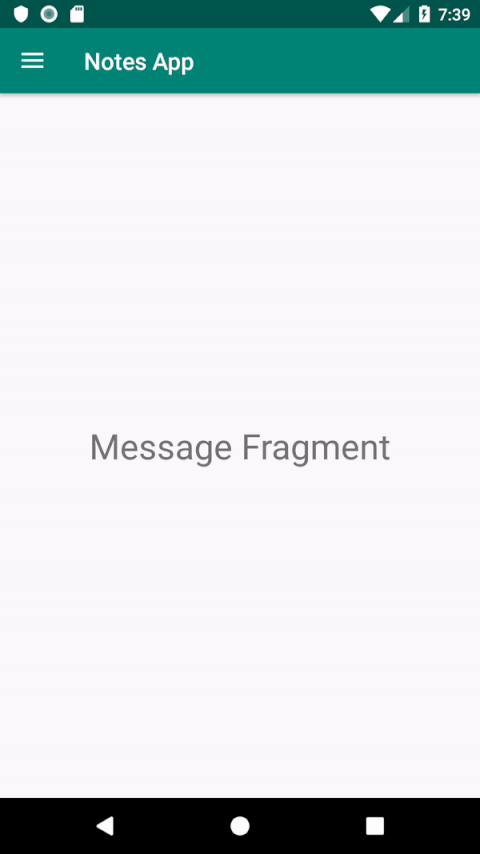

- #OPEN FRAGMENT 3 FROM NAVIGATION DRAWER DIRECTLY ANDROID HOW TO#
- #OPEN FRAGMENT 3 FROM NAVIGATION DRAWER DIRECTLY ANDROID ANDROID#
This code also ties everything together with the navigation so now, clicking on the navigation menu items will lead you to the corresponding fragment, provided you matched the names in the navigation and menu xml files. To start the project from where you left off in the previous practical, download the Android Studio project DroidCafe Part 3. This creates the link between your drawer layout and nav graph, gives it a controller, and also gives the toolbar the drawer icon. tupWithNavController(navController, appBarConfiguration)Ĭall this function in onCreate. tupWithNavController(navController)ĪppBarConfiguration = AppBarConfiguration(aph, drawerLayout) Val navController = navHostFragment.navController Val navHostFragment = supportFragmentManager.findFragmentById(R.id.nav_host_fragment) as NavHostFragment Setup the Navigation Drawer in code private lateinit var appBarConfiguration: AppBarConfiguration See below if you want a version of this with a custom toolbar. I could explain them all here but just look at the attributes above with the app namespace, those are the important bits, and quite frankly, self-explanatory. As you might guess, the FragmentContainerView is where the content of your fragments is gonna be, and the NavigationView is the drawer. After we set it up later, this will let the system make the link between the menu items and the fragments.Īt minimum, you need to have a DrawerLayout which has a FragmentContainerView and a NavigationView. What’s important here is that the ids of the fragments here match the ids of the menu items you set out earlier. In this case, we start at the home fragment which includes the action to go to the heroes page. This sets out the navigation journey your app follows. Create the nav graph xml Create an xml navigation under res/navigation. These are the menu items you want to have in your drawer. Create your menu xml Ĭreate an xml menu under res/menu.
#OPEN FRAGMENT 3 FROM NAVIGATION DRAWER DIRECTLY ANDROID HOW TO#
I’m gonna assume you already know how to make fragments so I’m not gonna go into detail there.

You need your home fragment, and any fragments you intend to navigate from the home fragment. Navigation components work through fragments. So I’m hoping that this article will set that straight once and for all.īy the way, if you’re interested in a mix of programming, Tekken, and Dota content on stream, follow me on Twitch your Fragments

Why did I do this? Because the documentation for doing the modern navigation drawer isn’t great. Of course there was the old way with massive chunks of boilerplate, which is what I resorted to on stream until I could replace it later. During it, I found lots of confusion with setting up the navigation drawer. We are going to keep things real simple so the UI is a bit ugly.So I’ve just done my first stream on Twitch, recreating an old app of mine, Dota Soundboard. Let’s get started coding the building blocks of our app: the fragments and their layouts. The Navigation component lets you create two different types of deep links: explicit and implicit. It’ll take you maybe 30 minutes, and you’ll have a better understanding of what we’re going to do here. In Android, a deep link is a link that takes you directly to a specific destination within an app. If you’re unfamiliar with navigation drawers, I suggest you run through the CodePath tutorial first. Get the source code for this project here. We’ll then reuse these fragments in a classic master/detail arrangement on tablets. Basically, we will have a master fragment that will be used for the drawer view and a detail fragment for the main view. Additionally, by implementing CodePath’s example, too much of the view logic would live in the hosted activity, so I set out to see if I could use fragments to solve this problem. There are a few ways to accomplish this “always open” behavior on tablets by using DrawerLayout.LOCK_MODE _LOCKED_OPEN, but I found them a bit hacky and inelegant. The navigation drawer is easily implemented with the Design Support Library, and the best walkthrough on how to build a navigation drawer is in this tutorial by CodePath. In this post, you’ll learn how to reuse fragments to give your tablet and phone users a great experience. The Android navigation drawer has become a ubiquitous UI feature on Android devices, but it’s usually unnecessary to hide and show on larger devices like tablets. With plenty of screen real estate, the drawer should stay open all the time the Material Design specs even recommend this behavior.


 0 kommentar(er)
0 kommentar(er)
